Alpha - The new beginning. The JMS-T2000GC AccuTOF™ GC-Alpha Time-of-Flight Mass Spectrometer, the ultimate GC-MS with improved performance and simplicity of use, opens up a new world of mass spectrometry.
The AccuTOF™ GC-Alpha employs two new key technologies in an effort to achieve excellent performance while keeping everything simple.
New High-performance Hardware for the Discerning User
The JMS-T2000GC AccuTOF™ GC-Alpha, a sixth-generation JEOL GC-TOFMS, uses an ideal ion optical system to provide high ion transmission (=sensitivity) and ultra-high resolution.
With the newly created hardware, the AccuTOF™ GC-Alpha has a mass accuracy of ≤1 ppm and a resolution that is six times greater than the AccuTOF™ GC of the first generation.
The AccuTOF™ GC-Alpha is the best option for GC-MS qualitative analysis as it is able to acquire an unmatched level of high-quality data.
A New Generation of Analysis Software for Simple, Speedy Operation
To detect unidentified compounds by GC-MS, an innovative technique has been developed. In this approach, the analytes present in a sample are identified by combining the data produced by hard ionization (EI) with the data obtained by soft ionization (FI, PI, CI).
The process is streamlined by the msFineAnalysis software, which also provides a new feature that allows two similar samples to be immediately compared for differential analysis.
The operator can quickly complete qualitative analysis for compounds unfamiliar to them and for compounds not recorded in the EI mass spectrum libraries with this new, improved version of msFineAnalysis.
Performance of AccuTOF™ GC-Alpha
High performance in both qualitative and quantitative analysis
Four “High” Specifications and Two “Wide” Specifications Achieved Simultaneously
The JMS-T2000GC AccuTOF™ GC-Alpha is a high-performance GC-MS system that simultaneously realizes high mass resolution, high mass accuracy, high sensitivity, high-speed data acquisition, wide dynamic range, and wide mass range.
The findings of the qualitative analysis are unparalleled due to the high mass resolution and accuracy. Advanced GC-MS measurements, including complete two-dimensional GC (GC×GC), can be performed using high-speed data collection, and complicated mixtures can be analyzed qualitatively and quantitatively thanks to the wide dynamic range.
For direct MS measurements, the wide mass range is highly beneficial, and high sensitivity allows for unprecedented information to be obtained regarding trace components.
The AccuTOF™ GC-Alpha is an extremely effective GC-MS system that eliminates the barriers to chemical analysis.
High Sensitivity
The standard EI ion source with ultra-high sensitivity can trace quantitative analysis.
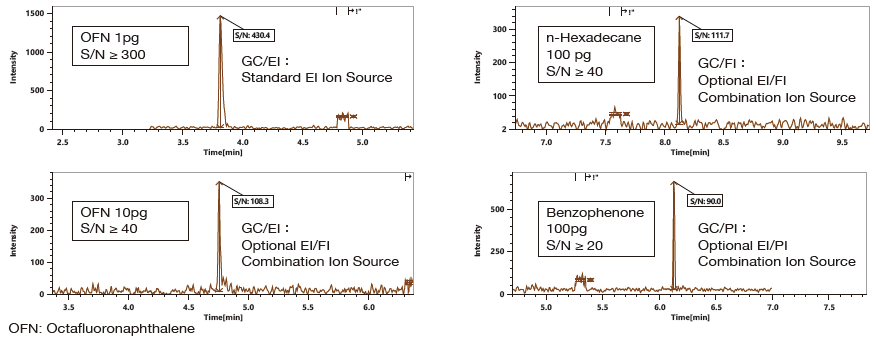
Image Credit: JEOL USA, Inc.
Instrument Detection Limit: IDL=18.7 fg
Using the conventional EI ion source, eight successive measurements of 100 fg of octafluoronaphthalene (OFN) were collected. Based on the peak area and repeatability of the extracted ion chromatogram for the molecular ion, the instrument detection limit (IDL) is determined. The system was able to attain an IDL of 18.7 fg.
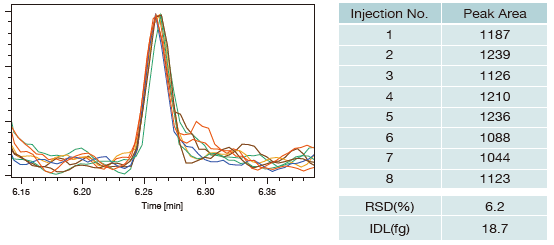
Image Credit: JEOL USA, Inc.
Wide Dynamic Range: Four Orders
The standard EI ion source was used to quantify OFN at concentrations ranging from 0.1 to 1,000 pg/uL (4 orders), and a high degree of linearity was shown. A complicated combination with various concentrations might benefit from the large dynamic range both for quantitative and qualitative investigation.
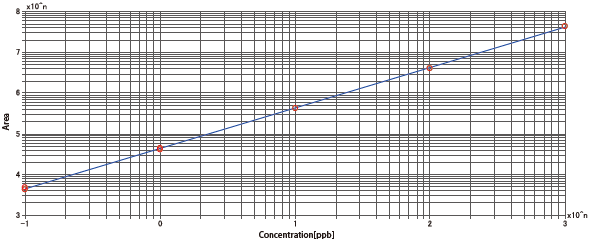
Image Credit: JEOL USA, Inc.
High Speed Data Acquisition: 50 Hz
For GCxGC and Fast GC analyses, the chromatographic peaks are very narrow, thus requiring a mass spectrometer that supports high-speed data acquisition.
The AccuTOF™ GC-Alpha is a good match for these advanced chromatographic methods as it can acquire data at up to 50 spectra per second.
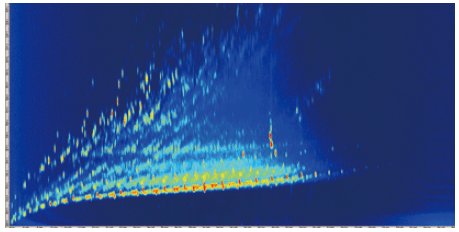
GC×GC/EI TICC of diesel fuel. Image Credit: JEOL USA, Inc.
Wide Mass Range: ~m/z 6,000
One of the features of time-of-flight mass spectrometers is their ability to measure a wide mass range. The upper limit of an ordinary GC-MS instrument is typically around m/z 1000, while the AccuTOF™ GC-Alpha can detect m/z 6000 and higher. This means that direct probe MS methods, such as field desorption (FD), can be used to measure samples like oligomers.
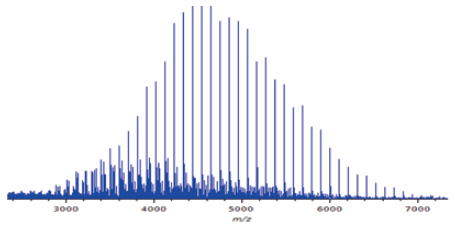
FD mass spectrum of polystyrene 5200. Image Credit: JEOL USA, Inc.
High Mass Resolving Power: 30,000
For qualitative analysis, high mass resolving power is essential. The characteristics below are the consequence of smaller mass spectral peaks that are produced by increasing the mass resolving power.
Higher peak centroid stability equals better mass accuracy
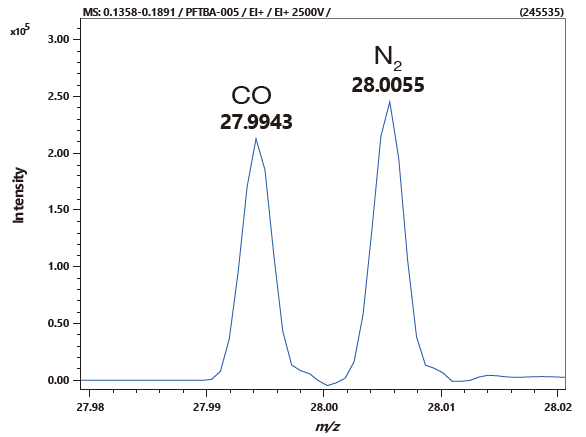
Mass separation of m/z 28. Image Credit: JEOL USA, Inc.
High Mass Accuracy: 1 ppm*1
The elemental compositions of the detected ions can be determined with high mass accuracy. The average mass accuracy (absolute value) for 10 ions detected from methyl stearate using the “drift compensation–multiple” mass calibration function was 0.05 mDa or 0.45 ppm.
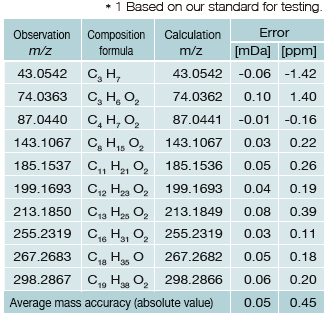
Image Credit: JEOL USA, Inc.

(Left) EI mass spectrum of PFTBA. (Right) EI mass spectrum of methyl stearate. Image Credit: JEOL USA, Inc.
New Qualitative Analysis Capabilities Offered by a Variety of Soft Ionizations
AccuTOF™ GC-Alpha offers a variety of ionization processes.
Soft Ionization – A Powerful Tool for Qualitative Analysis
EI, the most often used ionization method in GC-MS, is superior in terms of sensitivity and reproducibility, and it is supported by a number of library-searchable databases.
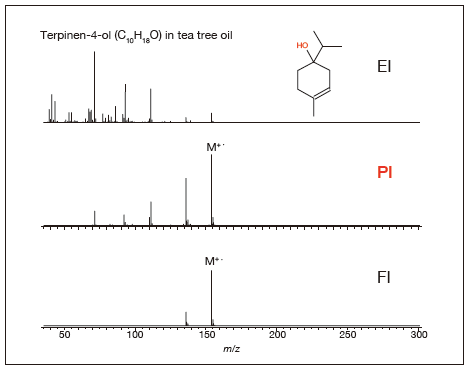
EI mass spectrum of methyl stearate. Image Credit: JEOL USA, Inc.
For any scientist that uses GC-MS to identify new information, molecular ion detection is crucial. EI, which uses a high ionization energy of 70 eV, generates numerous fragment ions, from which structural information is acquired.
However, EI often fails to show strong molecular ion signals. As such, qualitative analysis results can often be incorrect if they solely rely on database searches.
Thus, it is crucial in GC-MS analysis to improve qualitative analytical accuracy by employing several soft ionization methods in addition to EI. On the AccuTOF™ GC-Alpha, chemical ionization (CI), photoionization (PI), and field ionization (FI) are all options.
The elemental composition of the analyte can be accurately identified using the accurate mass measurement capability of all ionization methods.
FI and FD ~ Ideal Soft Ionization Techniques for Molecular Weight Determination
FI and FD are extremely soft ionization techniques that provide lower internal energy to the analytes than EI and even CI, thus generating clear molecular ions. As such, FI and FD are ideal for the determination of molecular weight.
- FI (Field Ionization)
- The sample is introduced to the ion source by GC or a standard sample inlet method
- Unlike CI, FI does not employ reagent gas; there is no need to select a reagent gas suited to the analyte
- FD (Field Desorption)
- Analyzes powder samples dispersible in solvents
- Analyzes low- to mid-polar metal complexes
- Analyzes high molecular weight samples not supported in GC-MS, such as polymers
- The sample is applied onto the emitter and directly introduced into the system
- Suitable for analysis of thermally labile compounds
- Ideal for samples soluble in nonpolar solvents
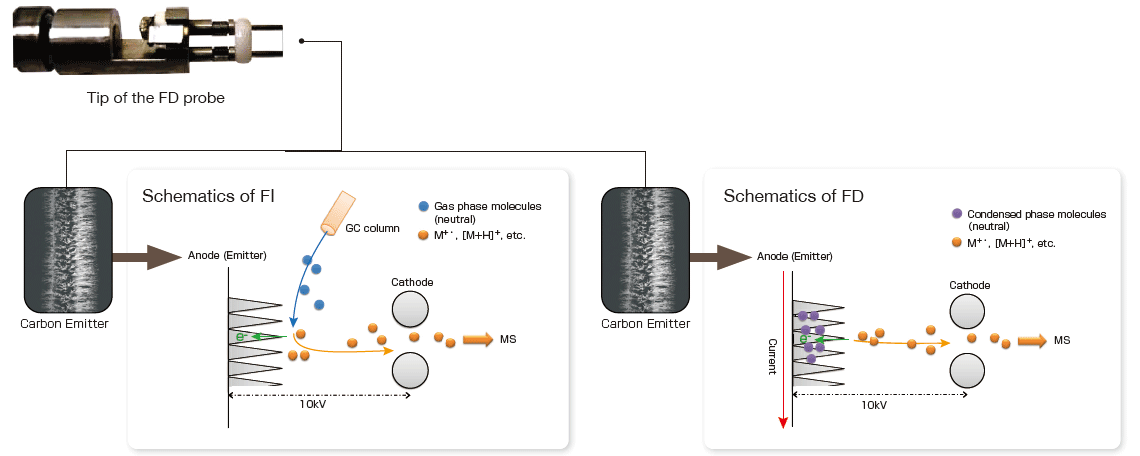
In FI and FD, ionization occurs by the removal of electrons from neutrals via the action of a high electric field. Image Credit: JEOL USA, Inc.
FI and FD ~ EI/FI/FD Combination Ion Source (optional)
A single ion source can be used for both EI (hard ionization) and FI/FD (soft ionization). It is simple and quick to switch between EI and FI/FD.
- Features
- No need to replace the ion source
- No need to break the vacuum
- No need for reagent gases
Using this combination of the ion source and GC, the following analyses are possible:
- GC/EI for qualitative analysis through library search
- GC/FI for molecular weight determination
- Accurate mass measurement
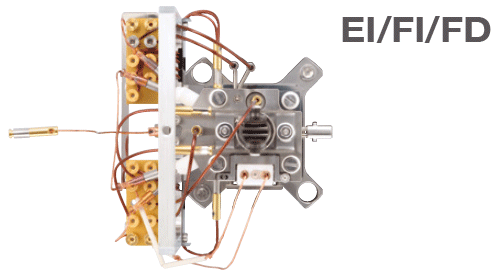
Image Credit: JEOL USA, Inc.
PI (Photoionization) ~ EI/PI Combination Ion Source (optional)
PI is an ionization technique that makes use of photons from a vacuum ultraviolet (VUV) lamp for ionization. The AccuTOF™ GC-Alpha has an optional combination ion source available that provides both EI (hard ionization) and PI (soft ionization). This source means that users can alternate between EI and PI by simply turning on/off the EI filament and the PI lamp.
- Features
- No need to replace the ion source
- No need to break the vacuum
- No need for reagent gases
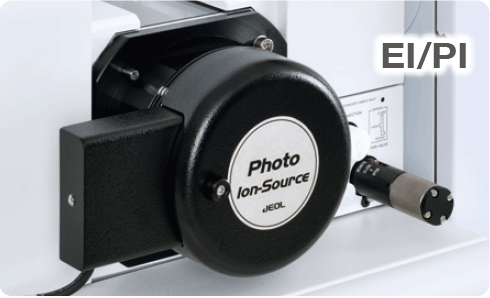
Image Credit: JEOL USA, Inc.
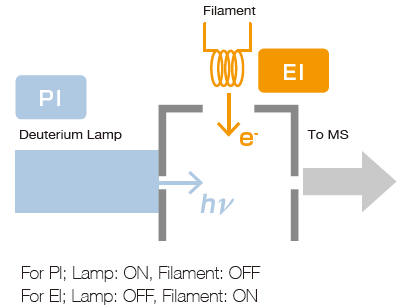
Schematics of EI/PI Combination Ion Source. Image Credit: JEOL USA, Inc.
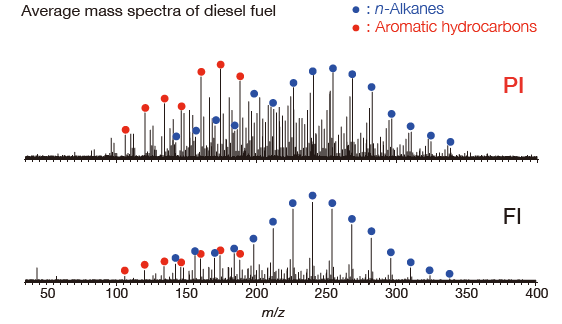
PI is particularly useful for the analysis of aromatic compounds in complex mixtures. These compounds produce high intensity peaks with PI because they strongly absorb UV light. Image Credit: JEOL USA, Inc.
AccuTOF™ GC-Alpha with Direct MS
Direct MS mode is beneficial for analyzing compounds with high boiling points and masses that are not accessible to GC.
TOFMS with Inherent Wide Mass Range is Well-Matched With Direct MS Mode
Compounds assessed by GC typically have molecular weights of less than 500 Da; hence it is uncommon to use GC-MS to target compounds with molecular weights of more than 1000 Da.
However, because the sample is injected directly into the ion source in direct MS mode (no GC is employed), high-boiling-point, high-molecular-weight, and nonvolatile compounds can be measured.
The AccuTOF™ GC-Alpha has a mass range of 6,000 or higher. As compounds can be detected over a broader mass range than conventional GC-MS, the system is well suited for measurements in direct MS mode.
Three Direct MS Probes to Choose From
- A sample dissolved or dispersed in a solvent is applied to the filament at the tip
- Suitable for high boiling point and/or thermally labile compounds
- Compatible with EI and CI

DEP (Direct Exposure Probe). Image Credit: JEOL USA, Inc.
- A solid sample can be introduced in the glass sample tube
- Suitable for high boiling point and/or insoluble compounds
- Compatible with EI and CI
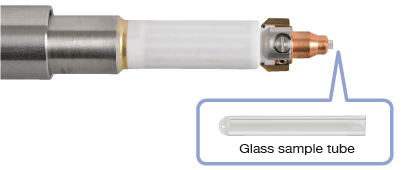
DIP (Direct Insertion Probe). Image Credit: JEOL USA, Inc.
- A sample dissolved or dispersed in a solvent is applied to the carbon emitter at the tip
- Suitable for high boiling point, high molecular weight, and/or thermally labile compounds
- Suitable for low- to mid-polar metal complexes
- Used for FD soft ionization
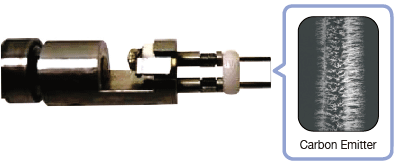
FDP (Field Desorption Probe). Image Credit: JEOL USA, Inc.
Polymer Analysis by FD and Kendrick Mass Defect (KMD) Analysis
FD is an ionization process in which analyte molecules are desorbed and ionized by a powerful electric field. The electric current going through the emitter is gradually raised during the measurement to heat the analyte to facilitate desorption/ionization.
Components can desorb at different times as the optimum emitter current for ionization depends on the analyte. Separation of components in a mixture is possible, and mass spectra for a specific class of compounds can be extracted.
Furthermore, even when compounds are not separated in time during desorption/ionization, target components can still be separated clearly by creating KMD plots.
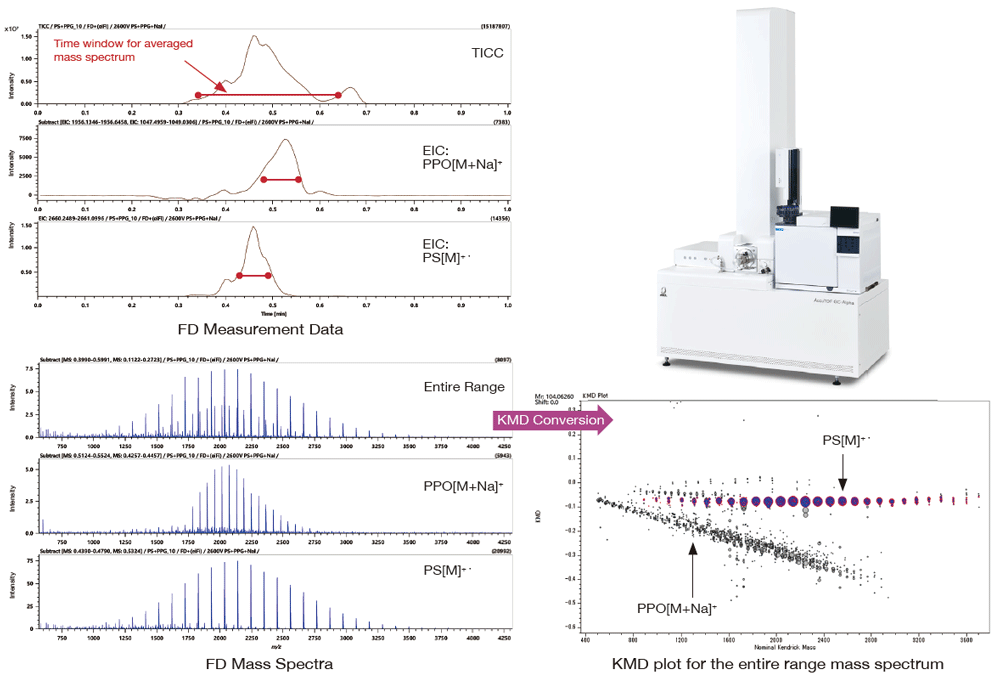
Image Credit: JEOL USA, Inc.
Key Features
- Wide Dynamic Range: 4 orders
- High-Speed Data Acquisition: 50 Hz
- High Mass Resolving Power: 30,000
- High Mass Accuracy: 1 ppm (based on our standard testing)
- Instrument Detection Limit: IDL=18.7 fg
- Wide Mass Range: ~m/z 6,000
Key Technologies
New High-Performance Hardware
The 6th generation JEOL GC-TOFMS, the JMS-T2000GC AccuTOF™ GC-Alpha, includes an upgraded ion optics system to reach an ultra-high resolution.
An orthogonal-acceleration time-of-flight mass spectrometer (oaTOFMS) with a dual-stage reflectron is the AccuTOF™ GC-Alpha. It uses a perfect ion optical system that achieves both extremely high resolution and high ion transmission.

The formula above is used to determine a time-of-flight mass spectrometer’s resolving power. The new JMS-T2000GC AccuTOF™ GC-Alpha hardware was created with this equation in mind and employs the following ideas to achieve ultra-high resolution:
- Make t longer: Increase the flight distance 4 m
- Make Δt smaller: New ion optical system using dual stage reflectron
- Make Δt smaller: Ion transfer system that can accommodate ions with a wide range of kinetic energy
With the newly developed hardware, the AccuTOF™ GC-Alpha features six times higher resolution than the first generation AccuTOF™ GC and has a mass accuracy of ≤ 1 ppm.
The AccuTOF™ GC-Alpha is the best option for GC-MS qualitative analysis as it acquires unmatched high-quality data.
A New Generation of Analysis Software for Simple, Speedy Operation
Unknown chemicals can now be identified by GC-MS using a novel process. This workflow combines the data produced by hard ionization (EI) and the data provided by soft ionization (FI, PI, CI) to identify the analytes present in a sample.
The msFineAnalysis software for the AccuTOF™ GC series has been favorably received since its launch in 2018 as a cutting-edge software solution for the automated qualitative analysis of unidentified compounds.
This software offers a novel method for qualitative analysis to identify unidentified compounds by effectively using the high-quality data provided by the AccuTOF™ GC-Alpha.
Evolution into Version 3
The software’s operation is simplified in version 3 of msFineAnalysis, which also introduces a new feature that allows two similar samples to be immediately compared for differential analysis.
The operator can quickly complete qualitative analysis for compounds unfamiliar to them and for compounds not recorded in the EI mass spectral libraries with this new, improved version of msFineAnalysis.
- Features of msFineAnalysis
- Combines EI/SI data for automatic qualitative analysis
- Chromatographic peak deconvolution
- Group analysis for extracting compounds with common substructures
- Differential analysis for directly comparing two samples
With the help of msFineAnalysis, users can quickly and effectively analyze data, freeing up more time for research and creative endeavors.
I
AccuTOF™ GC-Alpha Mass Spectrometer
Video Credit: JEOL USA, Inc.